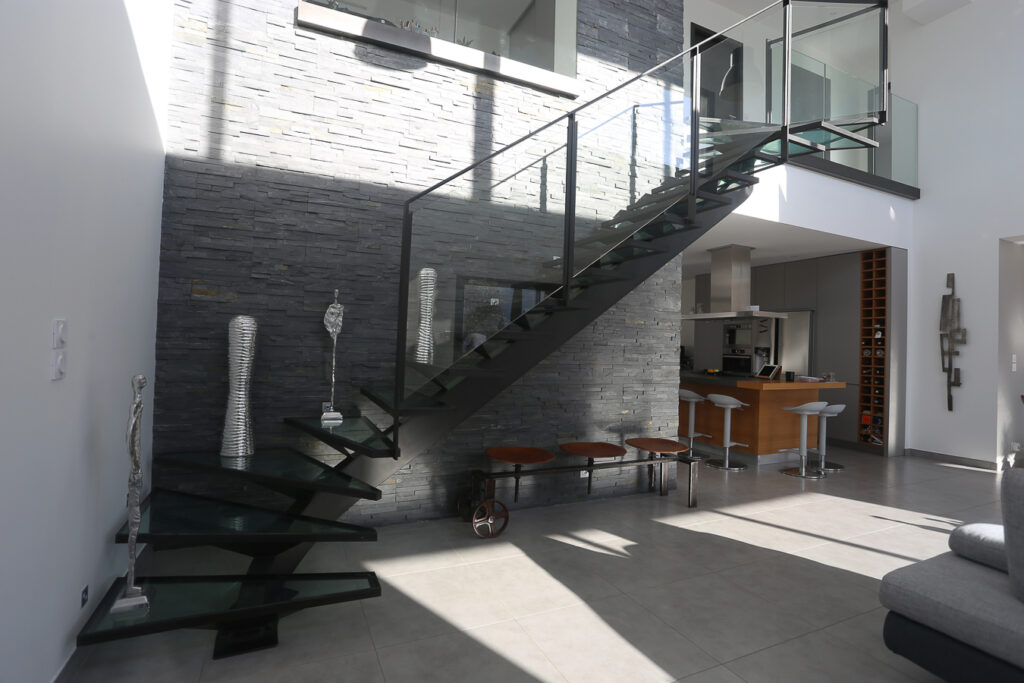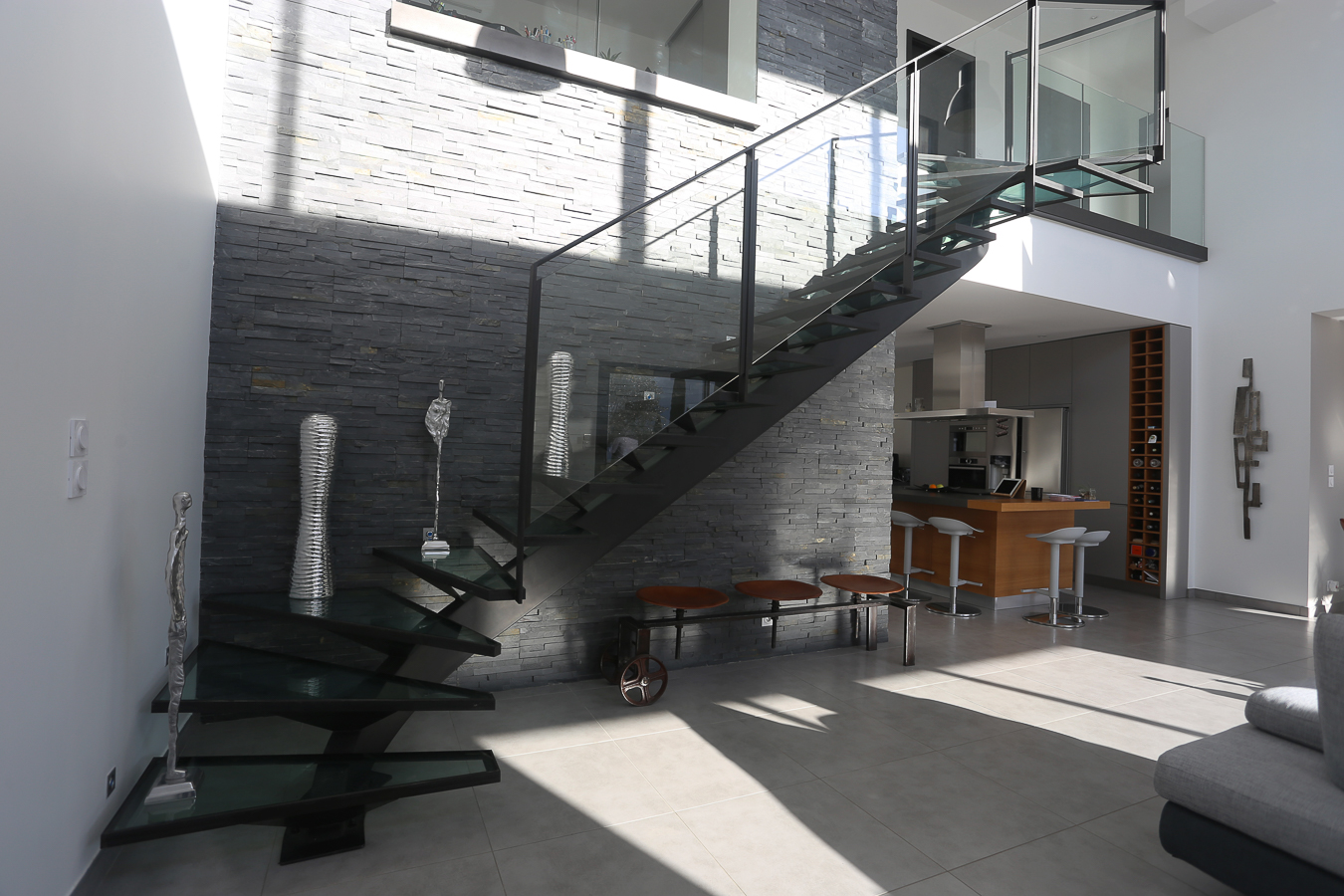
The Elegance and Engineering of the Central Stringer Staircase (Escalier à Limon Central)
The escalier à limon central, or central stringer staircase, represents a pinnacle of modern architectural design, blending structural integrity with aesthetic appeal. This type of staircase, characterized by a single, centrally located support, offers a minimalist and visually striking alternative to traditional staircases with multiple stringers. Its increasing popularity stems from its ability to create a sense of openness and lightness within a space, making it a preferred choice for contemporary homes and commercial buildings. Understanding the nuances of its design, construction, and advantages is crucial for architects, builders, and homeowners alike.
Understanding the Central Stringer Staircase
At its core, the escalier à limon central functions by transferring the load of the treads and risers to a single, robust central beam. This beam, often made of steel or reinforced concrete, acts as the spine of the staircase, providing the necessary support and stability. The treads, typically crafted from wood, glass, or metal, are then cantilevered or otherwise attached to this central stringer. This design eliminates the need for lateral supports, creating a floating effect that is both visually stunning and structurally sound.
The concept of the escalier à limon central isn’t entirely new, but advancements in materials science and engineering have allowed for increasingly sophisticated and daring designs. Modern techniques enable longer spans, thinner profiles, and greater load-bearing capabilities, pushing the boundaries of what’s possible with this type of staircase.
Design Considerations for a Central Stringer Staircase
Designing an escalier à limon central requires careful consideration of several key factors:
- Structural Integrity: The central stringer must be capable of supporting the weight of the staircase, including live loads from users. Calculations must account for the span, tread material, and expected traffic.
- Material Selection: The choice of materials for the stringer and treads significantly impacts the staircase’s aesthetics and performance. Steel offers strength and flexibility, while wood provides warmth and a natural feel. Glass treads can enhance the sense of openness, but require careful engineering to ensure safety.
- Code Compliance: Staircases must adhere to local building codes, which typically specify requirements for tread depth, riser height, handrail height, and overall safety. These codes are crucial for preventing accidents and ensuring accessibility.
- Aesthetics: The escalier à limon central is often a focal point of the interior design. The design should complement the surrounding architecture and reflect the overall style of the space.
- Installation: Proper installation is paramount to the staircase’s stability and longevity. A qualified contractor with experience in installing this type of staircase is essential.
Advantages of the Escalier à Limon Central
The escalier à limon central offers several distinct advantages over traditional staircase designs:
- Aesthetic Appeal: The minimalist design creates a sense of openness and lightness, making it an attractive option for modern interiors.
- Space Saving: By eliminating the need for multiple stringers, the escalier à limon central can often be more compact than traditional staircases, freeing up valuable floor space.
- Design Flexibility: The design can be tailored to fit a wide range of architectural styles, from sleek and modern to more rustic and industrial.
- Enhanced Natural Light: The open design allows for better light transmission, creating a brighter and more inviting space.
- Increased Property Value: A well-designed and executed escalier à limon central can significantly enhance the value of a property.
Potential Challenges and Considerations
While the escalier à limon central offers numerous benefits, it’s important to be aware of potential challenges:
- Cost: The design and construction of a central stringer staircase can be more expensive than traditional staircases due to the specialized engineering and fabrication required.
- Complexity: The installation process is more complex and requires skilled professionals with experience in this type of staircase.
- Perceived Instability: Some individuals may feel uneasy walking on a staircase that appears to be floating, especially if they are accustomed to more traditional designs. This is purely psychological, as a properly engineered escalier à limon central is perfectly safe and stable.
- Code Restrictions: Building codes may impose restrictions on the design and construction of central stringer staircases, particularly in areas with strict seismic requirements.
Materials Used in Central Stringer Staircases
The choice of materials plays a crucial role in the aesthetics, durability, and structural integrity of an escalier à limon central. Common materials include:
- Steel: Often used for the central stringer due to its high strength-to-weight ratio and ability to be easily fabricated.
- Wood: A popular choice for treads, offering warmth, natural beauty, and a variety of finish options.
- Glass: Can be used for treads to create a sense of transparency and lightness, but requires careful engineering and the use of tempered or laminated glass for safety.
- Concrete: Used for the central stringer, especially in industrial or minimalist designs.
- Stone: Can be used for treads, providing a luxurious and durable option.
Examples of Striking Escalier à Limon Central Designs
The versatility of the escalier à limon central is evident in the wide range of designs that have been implemented in residential and commercial spaces. Some notable examples include:
- Spiral Staircases: A central stringer spiral staircase can create a dramatic focal point in a room, saving space while adding a touch of elegance.
- Cantilevered Treads: Treads that appear to float independently from the central stringer, creating a truly minimalist aesthetic.
- Glass Tread Staircases: Staircases with glass treads that allow light to pass through, creating a bright and airy feel.
- Industrial-Style Staircases: Staircases with steel stringers and wooden treads, often incorporating exposed bolts and welds for an industrial aesthetic.
- Curved Staircases: Central stringer staircases that follow a gentle curve, adding a touch of sophistication and elegance to the space.
The Future of Central Stringer Staircase Design
As technology and materials science continue to advance, the possibilities for escalier à limon central design are virtually limitless. We can expect to see even more innovative and daring designs in the future, pushing the boundaries of what’s possible with this type of staircase. The integration of smart technology, such as integrated lighting and sensors, will further enhance the functionality and appeal of these staircases. [See also: Modern Staircase Design Trends] The growing demand for sustainable building practices will also drive the development of eco-friendly materials and construction techniques for central stringer staircases.
Conclusion
The escalier à limon central is more than just a functional element; it’s a statement piece that can transform the look and feel of any space. Its minimalist design, structural integrity, and design flexibility make it an increasingly popular choice for architects, builders, and homeowners alike. While careful planning and execution are essential, the rewards of a well-designed and installed escalier à limon central are well worth the effort. As design trends evolve, the escalier à limon central will undoubtedly remain a sought-after feature in contemporary architecture. Whether you’re renovating an existing home or designing a new building, consider the escalier à limon central as a way to elevate your space to new heights.

